|
There are over one million living arthropod species today. Arthropods are invertebrate animals (having no backbone or spine) with a hard, external skeleton (known as an exoskeleton), segmented bodies, and jointed appendages. See some of the arthropod fossils (52-million years old) on display in our visitor center exhibits. 
NPS/Arvid Aase 
NPS Photo Shrimp - Bechleja rostrataOrder Decapoda, Family PalaemonidaeThe Bechleja genus appears to have gone extinct sometime during the Eocene. Living members of the Palaemonidae family includes over 900 species that live in freshwater and marine waters. They are also known as prawns and are primarily carnivores. 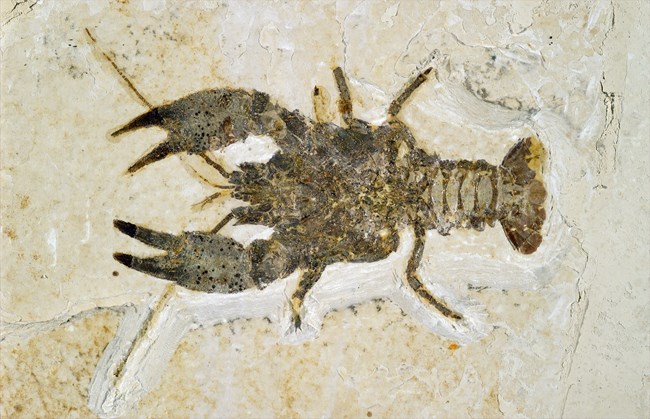
NPS Photo Crayfish - Procambarus primaevusOrder Decapoda, Family CambaridaeLiving members of the Procambarus genus include 160 species primarily found in warm freshwaters in North America and Central America. 
NPS Photo Spiders - 3 Unidentified SpeciesOrder Aranae
Three families have been identified from the FBM, but no species have been described. Together, the 3 families contain thousands of modern species. None of these species of spider use a web to catch prey. InsectsInsect fossils in the Fossil Butte Member (FBM) exist only as very thin carbon stains on the rock. Unlike fossil vertebrates (animals with a backbone), their skeletons are not visible beneath the rock. Insect specimens are found when the splitting rock layers split directly on the carbon stain.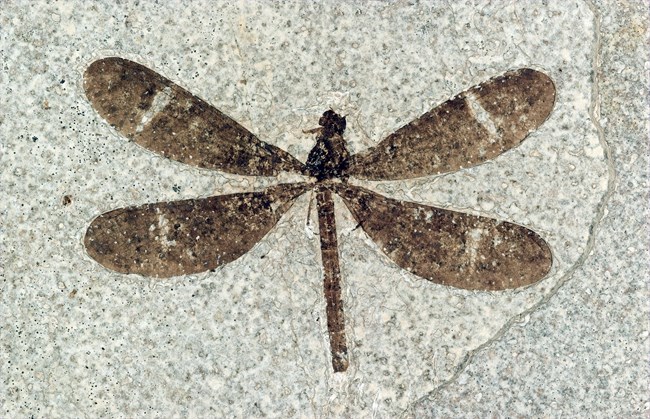
NPS Photo Dragonflies & DamselfliesOrder Odonata
Living members of the Odonata order are diurnal (active during the day) predator insects. They are exclusively freshwater insects during nymph state (juvenile stage). 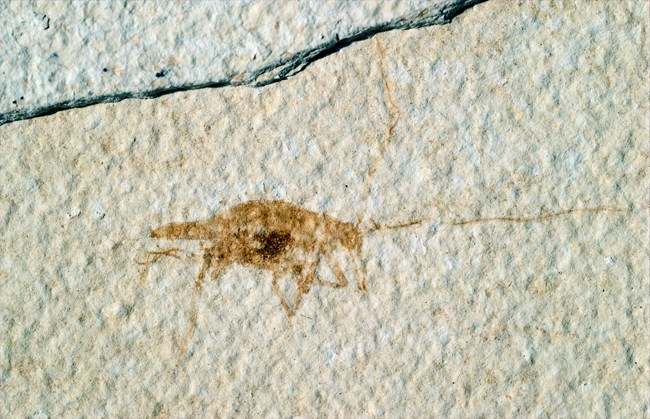
NPS Photo CricketsOrder Orthoptera, Family GryllidaeOf the Orthopteran order, which includes katydids, grasshoppers, locusts, and crickets, only cricket and grasshopper specimens are known from the FBM. None have been described as species, yet the crickets closely resemble the living family Gryllidae (true crickets). Living members of the Gryllidae family are nocturnal, omnivorous, and an important food source for amphibians, reptiles, and other arthropods. StonefliesOrder Plecoptera Fossils of stonefly nymphs have been found in the FBM. Modern stoneflies will spend 1-4 years as aquatic nymphs and live for several weeks as winged adults. The sole purpose of adulthood for these insects is to breed. To find a mate they “drum” the ground with their abdomen. Each drumming pattern is specific to the species. 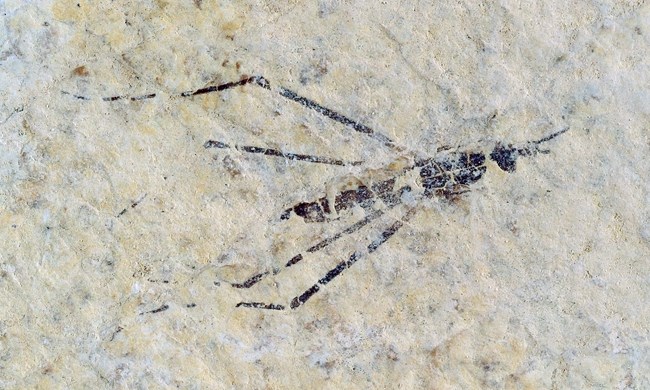
NPS Photo True BugsOrder Hemiptera While “bug” is a name usually applied to any small insect or arachnid with more than four legs, Hemipterans are a diverse order of insects formally referred to as true bugs. They are characterized by their sucking mouthparts and partially reinforced front wings. All bugs from the FBM are undescribed, but they have been grouped into the following families: · Scuterellidae (shield-backed / jewel bugs) · Petatomidae (stink bugs) · Cicadidae (cicadas) · Gerridae (water striders) · Cixiidae (primitive plant hoppers) · Achilidae (achilid leaf hoppers) · Fulgoridae (fulgorid leaf hoppers) Many Hemipterans are adapted to an herbivorous lifestyle, using their specialized mouthparts to extract plant juices. However, some are carnivorous; the water strider, a common Hemipteran in the FBM, uses its four hind legs to “skate” on the water’s surface and grabs smaller insect prey using its two front legs. 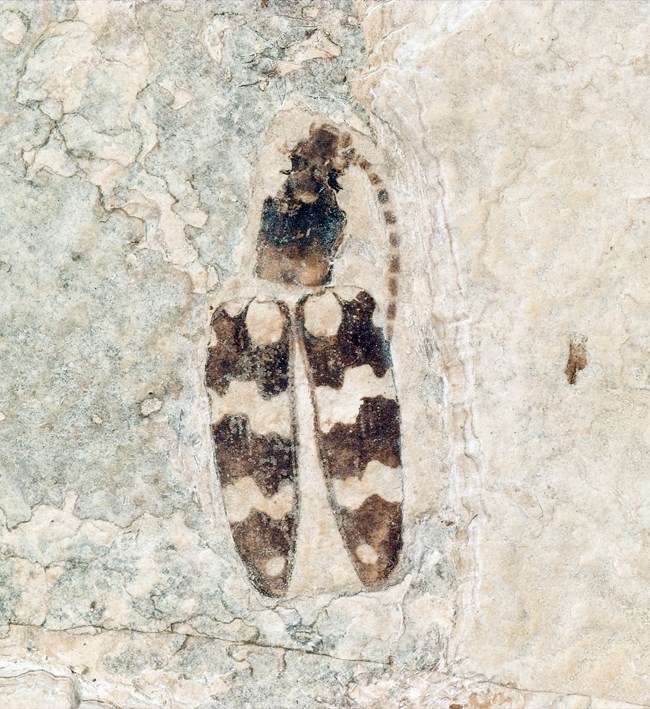
NPS Photo BeetlesOrder Coleoptera Beetles are the most diverse group of animals on the planet with over 350,000 described species and many more awaiting description. Their incredible diversity is still being processed, which makes the classification and description of fossil species difficult. None of the FBM Beetles have been described, but have been grouped into the following families: · Buprestidae (jewel/ metallic wood-boring beetles) · Carabidae (ground beetles) · Curculionidae (weevils) · Cupepidae (reticulated beetles) The largest (up to 2 in.) and most common FBM beetles are Buprestids. This family still exists, and are known for having bright, iridescent exoskeletons. Adults lay eggs in wood and the larvae eat the surrounding wood. When they metamorphose into adults, they consume mostly leaves. 
NPS Photo Ants, Bees, and WaspsOrder Hymenoptera Ants, wasps, and bees are all known for forming some of the most intricate social structures in the entire animal kingdom. These societies are generally composed of a reproductive queen, sterile workers, and soldiers that defend the hives/ colonies. The flightlessness of ants makes them uncommon in the FBM, but bees and wasps are comparatively more common. All of the FBM Hymenopterans are undescribed, but three families of wasp are recognized: · Vespidae (paper wasps, hornets, yellow jackets) · Ichneumonidae (parasitoid/ scorpion wasps) · Scollidae (flower wasps) The evolution of bees and wasps is closely tied to the evolution and diversification of flowering plants. The relationship between the FBM insects and the plant life in the area is evident due to the frequency of leaves found with predation from insects. The circular patterns in some leaves suggest a relative of modern leaf-cutter bees. Moths and ButterfliesOrder Lepidoptera Although lepidopterans are uncommon, the damage their caterpillars did to leaves 52-million years ago is frequently recorded in stone. All modern moths have a long, straw-like appendage for drinking nectar called a proboscis. At least two families are known from the FBM: · Saturniidae (royal and giant silk moths) · Pterophoridae (plume moths) Another lepidopteran family known from the FBM is Papilionoidea, which includes true butterflies. The fossil butterflies here are some of the first true butterflies to appear in the fossil record. 
NPS Photo FliesOrder Diptera Flies are, by far, the most abundant insect fossils in the FBM: over 90% are flies, and 80% are from just one species. That one species is Plecia pealei, a relative of today’s March flies (Bibioinidae). March flies are sometimes called “love bugs” because they are frequently seen mating and thus produce a lot of offspring. The resulting swarms are a likely explanation for their fossil commonality. In addition to March flies, these other fly families are known from the FBM: · Stratiomyidae (soldier flies) · Tipulidae (crane flies) · Sciaridae (dark-winged fungus gnats) · Empididae (dagger flies) · Chironomidae (non-biting midges) |
Last updated: September 26, 2025
